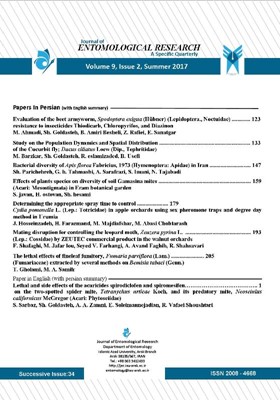Evaluation of the beet armyworm, Spodoptera exigua (Hübner) (Lep., Noctuidae) resistance to insecticides Thiodicarb, Chloropyrifos and Diazinon
Subject Areas : entomology and othea arthropodsM. Ahmadi 1 * , Sh. Goldasteh 2 , B. Amiri Besheli 3 , Z. Rafiei 4 , E. Sanatgar 5
1 - Department of Entomology, Islamic Azad University, Arak Branch, Arak, Iran
2 - Department of Entomology, Faculty of Agriculture, Islamic Azad University, Arak Branch, Arak, Iran
3 - Department of Crop Sciences, Sari Agriculture and Natural Resources University, Sari, Iran
4 - Department of Entomology, Faculty of Agriculture, Islamic Azad University, Arak Branch, Arak, Iran
5 - Department of Entomology, Faculty of Agriculture, Islamic Azad University, Arak Branch, Arak, Iran
Keywords:
Abstract :
The sugarbeet armyworm is one of the most important pests of sugar beet in Iran. However it is considered as a polyphagous pest. Owing to the inefficacy of most commonly used insecticides for the pest control, this study evaluated the sensitivity of two populations of the third instar larvae of Spodoptera exigua from two regions of Juibar and Gharakhil (north of Iran) to the insecticides Diazinon, Chloropyrifos, and Thiodicarb using enzymatic assessment. The results showed that the esterase activitiesof the third instar larvae of Juibar and Gharakhail colonies to thiodicarb was 0.196 and 0.302, for Chloropyrifos was 0.174 and 0.314 and for Diazinon was 0.099 and 0.285 μM /min/mg protein respectively. Based on the enzymatic activity, it can be reckoned that Spodoptera exigua from Juibar are more sensitive than those from Gharakhil. Enzymatic activity at various doses of pesticides showed significant differences between doses of the insecticides in the two populations. Increasing in dose of insecticides results decreases in esterase activities in Gharakhil and increase in population of Juibar. This indicates that the population of the beet armyworm in Gharakhil region is more resistant to the applied insecticides on population of Juibar.
_||_

